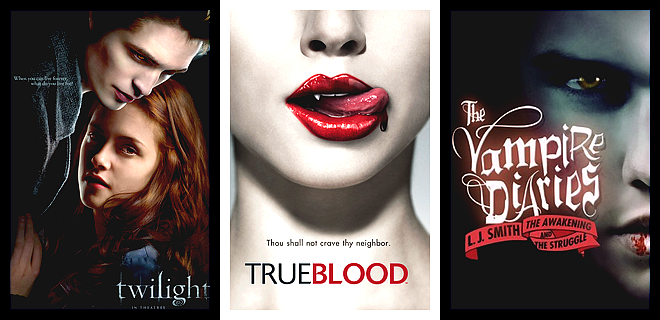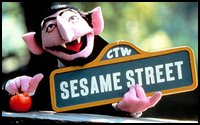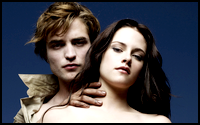
There are vampires among us.
What should have been a daunting statement now seems rather trivial, due to the overexposure of these mythical creatures in our modern society. Vampires exist not only in our literature, but also in our television shows, our cinema screens, and of course our Halloween parties. Lately, there seems to be no escape from these fanged monsters, not even in broad daylight. There are swarms of enthusiasts lined up outside of the bookstores and theatres, eagerly anticipating for the next instalment of their vampire franchise.
Vampires are not a recent phenomenon. These creatures of the un-dead have haunted our popular culture for centuries. From Bram Stoker’s classic gothic novel Dracula to Stephenie Meyer’s teenage romantic saga Twilight, vampires carry a prominent influence in many works of fiction. In fact, their creative potential seems endless. Rather than going out of style, these timeless characters grew stronger in mystique and intrigue. Former hit television shows like Buffy the Vampire Slayer and Angel introduced us to multi-faceted vampires that fall in between both ends of the moral spectrum. Recent cult favourites like True Blood and The Vampire Diaries further demonstrated the complexities of the supernatural community. Evidently, the momentum for this storytelling niche does not appear to be slowing down any time soon.
Analysis
Earlier fictional works focus on the fright of an ominous presence that lurks at night. Much like the notorious serial killer Jack the Ripper in the same era, Count Dracula was an intimidating figure due to its ability to contain so much inhumane evil within a seemingly human persona. The scariest monsters are the ones that could cloak their true nature and live among the normal civilians in society. Dracula not only epitomizes our fear of the unknown, but it also heightens our fear of the unsuspected.
Later works emphasize on the daily struggle of an immortal vampire. There is a poignant tragedy in a seemingly human creature that could not fit into society despite its good intentions. Whether it is their inability to appear in broad daylight, or their moral struggle between a guilty conscience and a desire for blood, vampires are intrinsically different from human beings regardless of their attempts to assimilate. The melancholy is magnified because they must bear with the burden of their nature for a restless eternity. Anne Rice’s Interview with the Vampire portrays a vampire protagonist that is doomed to perpetual pain and suffering, due to the multiple failures to sustain his humanity.
Another powerful theme is the unwilling victim. The innocent prey is an obvious example. If blood is the only means to a vampire’s survival, does it justify them from taking away precious human lives? More so, many vampires were the victims of unfortunate circumstances as well. Certainly, they did not become bloodsucking monsters based on their own free wills. Another moral dilemma is whether these vampires could inflict the same tragic fate upon another being, due to their first-hand experience of the struggles and suffering. Is it more merciful to drain a human completely from their mortal lives, or subject them eternally to the evils of the world?
What should have been a daunting statement now seems rather trivial, due to the overexposure of these mythical creatures in our modern society. Vampires exist not only in our literature, but also in our television shows, our cinema screens, and of course our Halloween parties. Lately, there seems to be no escape from these fanged monsters, not even in broad daylight. There are swarms of enthusiasts lined up outside of the bookstores and theatres, eagerly anticipating for the next instalment of their vampire franchise.
Vampires are not a recent phenomenon. These creatures of the un-dead have haunted our popular culture for centuries. From Bram Stoker’s classic gothic novel Dracula to Stephenie Meyer’s teenage romantic saga Twilight, vampires carry a prominent influence in many works of fiction. In fact, their creative potential seems endless. Rather than going out of style, these timeless characters grew stronger in mystique and intrigue. Former hit television shows like Buffy the Vampire Slayer and Angel introduced us to multi-faceted vampires that fall in between both ends of the moral spectrum. Recent cult favourites like True Blood and The Vampire Diaries further demonstrated the complexities of the supernatural community. Evidently, the momentum for this storytelling niche does not appear to be slowing down any time soon.
Analysis
| What exactly is the allure of vampires? A nocturnal monster that sucks human blood should have sounded terrifying, but we celebrate this symbol across a wide variety of mediums. Even Count von Count from Sesame Street, the most harmless of characters, is represented by a menacing looking Muppet with protruding fangs and a thunderous cackle. Vampires are meant to be scary. They could drain humans of all our blood, put us under a hypnotic trance, and attack through extraordinary strength. Different abilities vary among the fictional characters, but they are collectively depicted as a threat to the human species. |  |
Earlier fictional works focus on the fright of an ominous presence that lurks at night. Much like the notorious serial killer Jack the Ripper in the same era, Count Dracula was an intimidating figure due to its ability to contain so much inhumane evil within a seemingly human persona. The scariest monsters are the ones that could cloak their true nature and live among the normal civilians in society. Dracula not only epitomizes our fear of the unknown, but it also heightens our fear of the unsuspected.
Later works emphasize on the daily struggle of an immortal vampire. There is a poignant tragedy in a seemingly human creature that could not fit into society despite its good intentions. Whether it is their inability to appear in broad daylight, or their moral struggle between a guilty conscience and a desire for blood, vampires are intrinsically different from human beings regardless of their attempts to assimilate. The melancholy is magnified because they must bear with the burden of their nature for a restless eternity. Anne Rice’s Interview with the Vampire portrays a vampire protagonist that is doomed to perpetual pain and suffering, due to the multiple failures to sustain his humanity.
Another powerful theme is the unwilling victim. The innocent prey is an obvious example. If blood is the only means to a vampire’s survival, does it justify them from taking away precious human lives? More so, many vampires were the victims of unfortunate circumstances as well. Certainly, they did not become bloodsucking monsters based on their own free wills. Another moral dilemma is whether these vampires could inflict the same tragic fate upon another being, due to their first-hand experience of the struggles and suffering. Is it more merciful to drain a human completely from their mortal lives, or subject them eternally to the evils of the world?
 | The modern obsession with supernatural characters, especially vampires, is curious yet understandable. People gravitate towards a tragic story. They are also intrigued by their fear of the unknown and the unexplainable. Nowadays, the most successful vampire franchise features a highly sanitized love tale between a human and a glittering vampire. The forbidden romance is not a new narrative device, but our society is drawn to a story where the vampire can retain his humanity via the magical powers of love. Twilight sends an optimistic message that a tragic creature can still achieve happiness through human companionship. |
Vampires have become iconic in popular culture due to their brooding mystiques and tragic backstories. Centuries ago, our society fears of the unknown evil. Nowadays, we embrace the unknown with a cautious curiosity and a hopeful desire to see the good along with the bad. We draw parallels to the vampires in our stories, because they encompass many of our everyday moral struggles. The optimistic modernity wants to root for these tragic antiheroes, for them to overcome their hardships and to discover solace in an endless midst of sorrow.
Vampires In Popular Culture
BOOKS
• Dracula
The 1897 gothic horror novel by Bram Stoker remains a classic to this day. The narrator, Jonathan Harker, encounters a mysterious employer with a secret lifestyle. After a narrow escape from the castle, our protagonist runs into evil again, as Count Dracula strikes against his close companions. He and his lover Mina must find a way to fight the malevolent creature before they fall victim to his influences.
• Interview with the Vampire
The first book in Anne Rice’s Vampire Chronicles series is known for its tragic and possibly even sympathetic depiction of the vampire culture. Louis is a 200-years-old vampire who relays his entire life story to a curious journalist. His melancholy past is filled with sorrow and suffering, from tales of unspeakable violence to memories of unpreventable deaths, as Louis struggles to retain the last shreds of his humanity.
• Anno Dracula
Kim Newman’s book series offer an interesting take on an alternative universe to Bram Stoker’s Dracula. Imagine a world where Count Dracula was not defeated, and had instead dominated society completely. In the first book, a serial killer of vampire prostitutes is on the loose. Jack the Ripper, who turns out to be Jack Steward from the original Dracula novel, is determined to avenge for his lover’s death in this tyrannical world.
• Twilight
Spanned over four books, Stephenie Meyer’s teenage love story has become a juggernaut in pop culture. Bella Swan was a typical teenage girl in a small town, until she met and fell in love with a vampire named Edward Cullen. Despite their instant attraction to each other, Edward and Bella experience a complicated romance, especially with a werewolf love interest thrown into the mix.
TELEVISION
• True Blood
Based on The Southern Vampire Mysteries by Charlaine Harris, this popular HBO television series features a telepathic waitress in a small Louisiana town. After the invention of sustainable synthetic blood, vampires are reluctantly accepted into mainstream society, with much protest over their unequal rights. Our protagonist, Sookie Stackhouse, encounters a vampire at the restaurant one night. And her life is about to change…
• The Vampire Diaries
CW’s own vampire television series is based on L. J. Smith’s book series of the same title. Tragic heroine Elena Gilbert is caught in the middle of a love triangle between two vampire brothers. Through their involvement in her life, she discovers several profound secrets about herself and her small Virginian town. This includes the whole truth about the dreadful car accident that took both of her parents’ lives.
• Buffy the Vampire Slayer
This highly successful Joss Whedon production takes on a much darker tone from its 1992 film predecessor. As a Slayer, Buffy Summers is charged with the responsibility of battling various supernatural occurrences in her small Californian town. Her misadventures are made even more chaotic by a never-ending cycle of evil villains that are eager to bring Buffy down.
• Angel
This Buffy spinoff showcases a vampire named Angel, who is cursed with a guilty conscience as he atones for his past sins and crimes. The benevolent vampire’s quest for redemption takes him to the city of Los Angeles, where he and a team of associates help out the lost souls in a format similar to a detective agency. Instead of solving regular crimes, they challenge demons and other paranormal presences.
• Being Human
BBC’s hit television series, and its inspired American remake of the same name, is about three supernatural characters that try to integrate into society despite their unusual afflictions. The trio consists of a ghost, a werewolf, and a vampire, all struggling to maintain a regular social life. The three friends must help each other navigate their peculiar lifestyles, while concealing their dark secrets from the world.
• Supernatural
With great appeal to CW’s prominent female demographic, two handsome brothers go on various paranormal adventures to hunt demons and other supernatural creatures, including vampires. Sam and Dean Winchester initially seek for their missing father in the first season. Later seasons involve soul exchanges, misadventures in hell, and battling the impending Apocalypse.
• The Gates
In this 2010 summer series by ABC, a variety of supernatural creatures live within a contained community called The Gates. Among the witches and werewolves, Claire Radcliff struggles to suppress her vampirism beneath a suburban housewife persona. She has to deal with her moody husband and their adopted daughter, the untrusting police chief and his unsuspecting wife, as well as a shrewd and manipulative witch.
YOUTUBE VIDEO





No comments:
Post a Comment